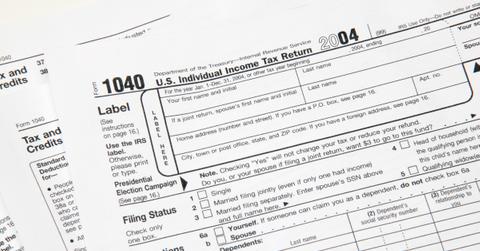Why Was My Tax Return Rejected? Primary Causes, Explained
Tax season has started and the IRS will reject some tax returns. The primary causes of tax return rejection are minor errors like incorrect spelling or identification numbers.
Jan. 25 2022, Published 12:34 p.m. ET

Tax returns are due April 18. Here's what to do if your return is rejected.
Americans are starting to prepare their tax returns for 2021. The tax season’s officially started on Jan. 24 and the filing deadline is April 18, 2022. Millions of citizens will file their tax returns electronically, which the IRS recommends instead of filing paper returns.
Even if you file an electronic tax return, it’s possible that an error could cause the IRS to reject your tax return. In general, your tax return will only be rejected if there's a mistake, like an incorrect Social Security number, a missing form, or a misspelled name.

The IRS encourages e-filing for all Americans to expedite the tax process.
Most tax return rejections are due to an error.
The IRS explicitly states in its FAQ section that if your electronic tax return gets rejected, “There must be an error on your tax return.” The other possibility is that the IRS suspects some sort of fraud or identity theft, which you might not even be aware of.
Some of the more common errors on tax returns are mistakes with Social Security numbers, the payer’s identification numbers, or names. Another common problem is when taxpayers omit a required form. You should receive an explanation of why your return was rejected.
Which errors can be easily corrected via e-file?
According to the IRS, many of the common errors on taxpayer forms can be quickly and easily remedied online. The following tax return issues can get corrected and then you simply resubmit the electronic tax return.
Incorrect Social Security Number
Incorrect payer identification number
Missing form
Misspelled name
Errors in other personal information like your date of birth or address
For those who used tax preparation software, most software platforms provide guidance for those seeking to correct tax return errors.
H&R Block notes that some tax returns are rejected because someone is fraudulently filing a return with someone else’s SSN.

IRS.gov provides information for all taxpayers.
What's the quickest way to get a tax refund?
The IRS emphasizes that filing electronically is the most efficient way to complete your tax-filing obligations. This method, combined with direct deposit, ensures the fastest possible delivery of any tax refund you're eligible to receive.
The IRS estimates most people will receive their refund within 21 days of filing if they file electronically and sign up for a direct deposit.
Some issues will require manual review by the IRS.
Certain issues, especially those involving suspected fraud or identity theft, might require manual review by the IRS and the agency might need to correspond with you. Certain issues might require filing a paper return, and you can verify this with the IRS if you find you can’t easily fix errors electronically.
The IRS will notify the taxpayer with an explanation if they're able to correct errors without corresponding first. However, for certain situations, it might take longer than the typical 21 days to process a refund due to an IRS employee having to handle the situation.
Will there be tax credit delays?
Taxpayers expecting to receive either the Earned Income Tax Credit or Additional Child Tax Credit should know that those can't be refunded until at least mid-February. The IRS is provided more time by law in order to help prevent the issuance of fraudulent refunds.
